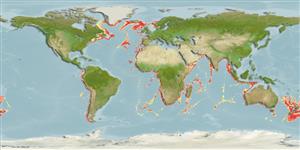Classification / Names
Common names from other countries
Main reference
Size / Weight / Age
Max length : 75.0 cm TL male/unsexed; (Ref. 36696); common length : 40.0 cm TL male/unsexed; (Ref. 4181); max. published weight: 7.0 kg (Ref. 36697); max. reported age: 149 years (Ref. 3680)
Length at first maturity
Lm 37.0, range 18 - 32.5 cm
Environment
Marine; bathypelagic; oceanodromous (Ref. 51243); depth range 180 - 1809 m (Ref. 6390), usually 400 - 900 m (Ref. 3583)
Climate / Range
Deep-water; 3°C - 9°C (Ref. 36694), preferred 19°C (Ref. 107945); 65°N - 56°S, 84°W - 168°W
Distribution
Western Atlantic: Gulf of Maine (Ref. 4784) [in error according to Moore (Fishes of the Gulf of Maine, in press), should be off northern Nova Scotia]. Eastern Atlantic: Iceland to Morocco; Walvis Bay, Namibia to off Durban, South Africa. Indo-Pacific: south-central Indian Ocean and New Zealand. Eastern Pacific: Chile (Ref. 27363). Several stocks may exist as suggested by distinct spawning sites and seasons.
Countries | FAO areas | Ecosystems | Occurrences | Introductions
Short description
IUCN Red List Status (Ref. 115185)
Threat to humans
Harmless
Human uses
Fisheries: highly commercial
Tools
Special reports
Download XML
Internet sources
Estimates of some properties based on models
Phylogenetic diversity index
PD50 = 0.5000 many relatives (e.g. carps) 0.5 - 2.0 few relatives (e.g. lungfishes)
Trophic Level
4.3 ±0.1 se; Based on diet studies.
Resilience
Very Low, minimum population doubling time more than 14 years (K=0.04-0.06; tm=5-33; tmax=140; Fec=10,000)
Vulnerability
High to very high vulnerability (73 of 100)
Price category
